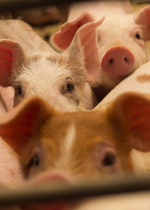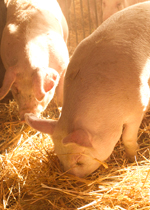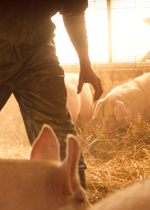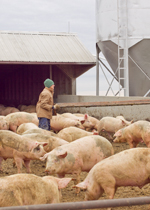 |
|
No Growth Promotants
In addition to antibiotics, growth promotants are also commonly added to the diets of commodity pigs, during the last few weeks just prior to their going to market.
Their intent is to improve the efficiency of feed conversion, increasing the accumulation of protein in muscle and reducing fat growth. This results in a leaner carcass. |
|
 |
|
 |
| Inquisitive pigs interested in what the stockman is doing. |
|
Relaxed growing pigs rooting in fresh straw. |
| |
 |
|
 |
| Farmer working comfortably in a pen full of growing pigs. |
|
Calm pigs allow farmers to work. |
| |
|
|
|
In the United States, Federal law prohibits the use of hormones in pork and poultry. However, the use of beta agonists is still widespread. Beta agonists mimic the effects of transmitters for the sympathetic nervous system, which mobilizes our fight-or-flight response. While beta-blockers (which are commonly prescribed for individuals who are vulnerable to heart attack) weaken the stress response, beta-agonists do the opposite.
Ractopamine was first developed to treat asthma, but never approved for that purpose. It increases heart rate and the adrenal response in pigs. Which means that the pigs become wild, jumpy, and extremely stressed. They are easily startled, difficult to herd, and dangerous to work around. Keep in mind that pigs at this age, though not aggressive, are agile, well-muscled, athletic, and approach 240 to 260 pounds, so it's easy to accidentally get hurt by them when they are in an unnaturally adrenalized state. They are also more likely to injure themselves while being transported and herded to slaughter.
Although such growth promotants may lead to a leaner carcass, the effects on the meat aren't all that good. There is reduced marbling and, of course, tenderness, as a result of the pigs' muscles being held in a constant state of fight-or-flight tension over a course of weeks.
Although ractopamine is fed to the majority of pigs marketed in the United States, it is not legal in the European Union and has been banned from pork exported to China and other leading importers of American pork.
Truebridge has also taken a stand against feeding growth promotants to pigs. Both the customer and the farmer are negatively impacted, but it is most difficult to watch its effects on pigs. When you walk in a Truebridge pig pen, even if you are a stranger, like the person in the photo above, the pigs crowd around you happily and curiously, without any drugs to distort their natural behavior.
Not feeding growth promotants to their pigs means that Truebridge pigs take about two weeks longer and thirty pounds more food, to reach market weight. Truebridge farmers understand that being socially responsible costs time, money, and substantially more effort. But they believe it's worth it, because they are the ones on the front line, seeing the difference.
|